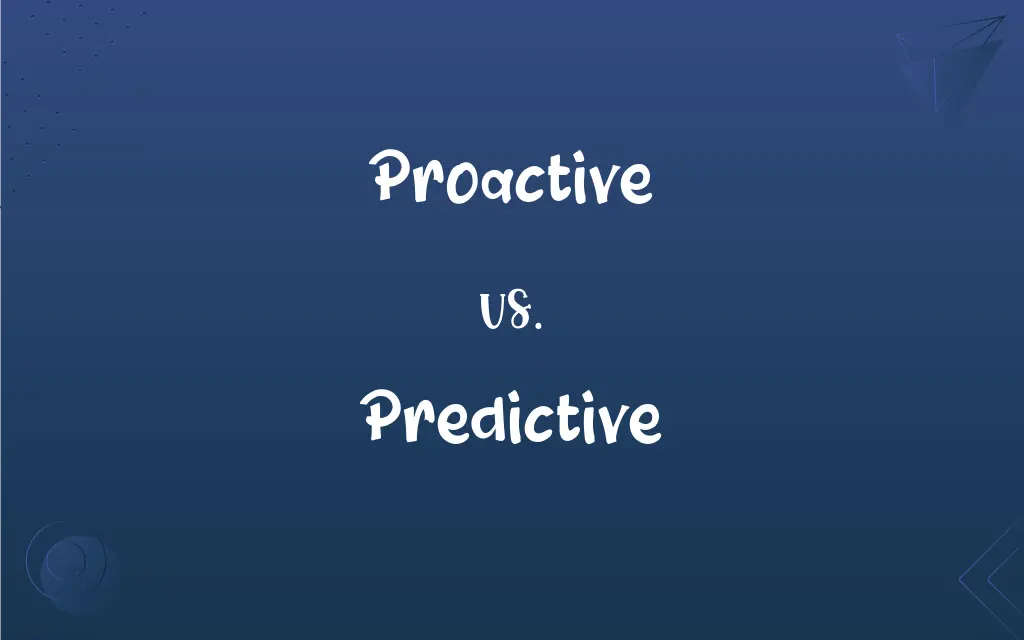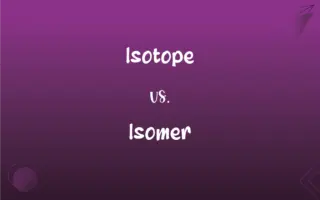Proactive vs. Predictive: What's the Difference?
By Aimie Carlson & Janet White || Updated on March 4, 2024
Proactive involves taking initiative to prevent problems before they occur, while predictive uses data analysis to foresee and prepare for potential issues.

Key Differences
Proactive behavior focuses on taking control and initiating action to prevent future problems or to achieve positive outcomes. It's about making things happen rather than waiting for them to happen. This approach is characterized by planning, preparation, and prevention, aiming to avoid potential issues before they arise. Predictive behavior, on the other hand, relies heavily on data analysis and forecasting to anticipate future events or trends. It involves using historical data, statistical algorithms, and machine learning techniques to identify the likelihood of future outcomes.
While proactive strategies are based on general good practices and principles to avoid potential problems, predictive strategies are more focused and specific, using data to pinpoint exactly when and where issues are likely to occur. This makes predictive approaches more efficient in terms of resource allocation but also requires more sophisticated data analysis capabilities.
Both proactive and predictive approaches aim to mitigate risks and improve outcomes but differ in their methods and focus. Proactive actions are taken regardless of whether specific problems are known to be imminent, emphasizing readiness and prevention. Predictive actions, however, are taken in response to specific, forecasted risks, emphasizing efficiency and precision.
The choice between proactive and predictive approaches depends on the context and available resources. In environments where data is abundant and predictive analytics capabilities are strong, predictive strategies can offer significant advantages. However, in situations where data is limited or the ability to analyze it is not well developed, a proactive approach may be more practical and effective.
Comparison Chart
Definition
Taking initiative to prevent problems.
Using data to foresee and prepare for issues.
ADVERTISEMENT
Focus
Prevention and readiness.
Forecasting and efficiency.
Method
General principles and planning.
Data analysis and statistical forecasting.
Application
Broad actions taken to avoid potential issues.
Specific actions based on predicted risks.
Requirements
Planning and preparation capabilities.
Data collection and analysis capabilities.
Proactive and Predictive Definitions
Proactive
Characterized by initiative and control.
Proactively seeking feedback to improve products before complaints arise.
ADVERTISEMENT
Predictive
Requires data analysis capabilities.
Implementing a predictive lead scoring system to prioritize sales efforts.
Proactive
Involves planning and preparation.
Proactively stocking up on supplies before a forecasted storm.
Predictive
Relies on historical data and algorithms.
Using predictive maintenance to schedule service for machinery.
Proactive
Taking early action to avoid potential problems.
A company implements regular training to proactively improve employee skills.
Predictive
Foreseeing potential issues using data.
Predictive analytics forecast sales trends to manage inventory.
Proactive
Aims for readiness and prevention.
Installing fire alarms in all buildings as a proactive safety measure.
Predictive
Specific and targeted actions.
Predictive alerts for potential security breaches in IT systems.
Proactive
Applies regardless of specific known risks.
Regular health check-ups for proactive wellness management.
Predictive
Aims for efficiency by anticipating needs.
Predictive modeling to optimize staffing levels during peak hours.
Proactive
Acting in advance to deal with an expected difficulty; anticipatory
Proactive steps to prevent terrorism.
Predictive
To state, tell about, or make known in advance, especially on the basis of special knowledge
Predicted an active hurricane season because of warmer ocean-surface temperatures.
Proactive
Acting in advance to deal with an expected change or difficulty
We can deal with each problem as it pops up, or we can take a proactive stance and try to prevent future problems.
Predictive
To foretell something.
Proactive
Descriptive of any event or stimulus or process that has an effect on events or stimuli or processes that occur subsequently;
Proactive inhibition
Proactive interference
Predictive
Useful in predicting.
The amount of rain in April is predictive of the number of mosquitoes in May.
Proactive
(of a policy or person or action) controlling a situation by causing something to happen rather than waiting to respond to it after it happens
Predictive
(computing) Describing a predictor.
Predictive
(medicine) Expressing the expected accuracy of a statistical measure or of a diagnostic test.
Predictive
(grammar) A conditional statement that includes a prediction in the dependent clause (e.g. "if it rains, the game will be cancelled", "give her an inch and she'll take a mile.").
Predictive
(statistics) Simulated data generated from a statistical model, based on the estimates for the real data.
Predictive
Foretelling; prophetic; foreboding.
Predictive
Of or relating to prediction; having value for making predictions
FAQs
Can proactive and predictive approaches be combined?
Yes, combining proactive and predictive approaches can provide comprehensive risk management and opportunity maximization by leveraging both planning and data-driven insights.
What are the benefits of a proactive approach?
The benefits of a proactive approach include reduced risks, better preparedness, improved efficiency, and the ability to prevent issues before they escalate.
What industries use predictive analytics?
Industries using predictive analytics include finance, healthcare, retail, manufacturing, and technology, among others, to improve decision-making and operational efficiency.
How does predictive analysis work?
Predictive analysis uses historical data, statistical algorithms, and machine learning techniques to forecast future events, trends, or behaviors.
How do I choose between a proactive and predictive approach?
Choosing between a proactive and predictive approach depends on the specific context, goals, available data, and analysis capabilities. A combined approach often yields the best results.
What are common mistakes in implementing proactive strategies?
Common mistakes in implementing proactive strategies include failing to adequately assess risks, underestimating the resources required for implementation, neglecting to monitor and adjust plans as needed, and overlooking the importance of stakeholder engagement.
How do predictive models benefit businesses?
Predictive models benefit businesses by enabling more informed decision-making, optimizing operations, enhancing customer experiences, and predicting future trends or behaviors.
What is proactive behavior?
Proactive behavior involves taking initiative and action in advance to prevent problems or seize opportunities, focusing on readiness and prevention.
How can organizations develop a proactive culture?
Organizations can develop a proactive culture by encouraging initiative, rewarding forward-thinking actions, providing training on proactive strategies, and emphasizing the importance of anticipation and prevention in achieving goals.
How do environmental factors influence proactive and predictive strategies?
Environmental factors, such as market volatility, technological advancements, and regulatory changes, can influence the effectiveness of proactive and predictive strategies by affecting the predictability of future events and the relevance of past data.
What skills are needed for predictive analysis?
Skills needed for predictive analysis include data collection and cleaning, statistical analysis, machine learning, and the ability to interpret and communicate findings.
What role does technology play in predictive analytics?
Technology plays a crucial role in predictive analytics by providing the tools and platforms for data processing, statistical analysis, machine learning, and the visualization of predictive insights, enabling more accurate and efficient forecasting.
How can small businesses benefit from predictive analytics?
Small businesses can benefit from predictive analytics by gaining insights into customer behavior, optimizing inventory levels, improving marketing strategies, and identifying growth opportunities, even with limited resources.
What are the ethical considerations in predictive analytics?
Ethical considerations in predictive analytics include data privacy concerns, the potential for biased data leading to unfair predictions, and the need for transparency in how predictive models are developed and used.
Why is being proactive important?
Being proactive is important because it allows individuals and organizations to anticipate and mitigate risks, leading to better outcomes and avoiding potential crises.
What is the future of predictive analytics?
The future of predictive analytics involves increased integration of artificial intelligence and machine learning technologies, greater accessibility for non-experts, and broader applications across industries, leading to more sophisticated and actionable insights.
How can predictive analytics impact customer experiences?
Predictive analytics can significantly enhance customer experiences by personalizing recommendations, anticipating customer needs, optimizing interaction points, and proactively addressing potential issues, leading to higher satisfaction and loyalty.
How do cultural differences affect proactive and predictive behaviors?
Cultural differences can affect proactive and predictive behaviors by influencing attitudes towards risk, uncertainty, and the value placed on planning versus adaptability, which can impact the adoption and effectiveness of these strategies in different contexts.
What are the limitations of predictive analytics?
Limitations of predictive analytics include the potential for inaccurate predictions due to poor quality data, overreliance on models, and the need for continuous updates and adjustments.
How do proactive and predictive approaches impact risk management?
Proactive and predictive approaches impact risk management by allowing organizations to identify potential risks earlier, implement mitigation strategies more effectively, and allocate resources more efficiently, thereby reducing the overall risk exposure.
About Author
Written by
Aimie CarlsonAimie Carlson, holding a master's degree in English literature, is a fervent English language enthusiast. She lends her writing talents to Difference Wiki, a prominent website that specializes in comparisons, offering readers insightful analyses that both captivate and inform.
Co-written by
Janet WhiteJanet White has been an esteemed writer and blogger for Difference Wiki. Holding a Master's degree in Science and Medical Journalism from the prestigious Boston University, she has consistently demonstrated her expertise and passion for her field. When she's not immersed in her work, Janet relishes her time exercising, delving into a good book, and cherishing moments with friends and family.































































